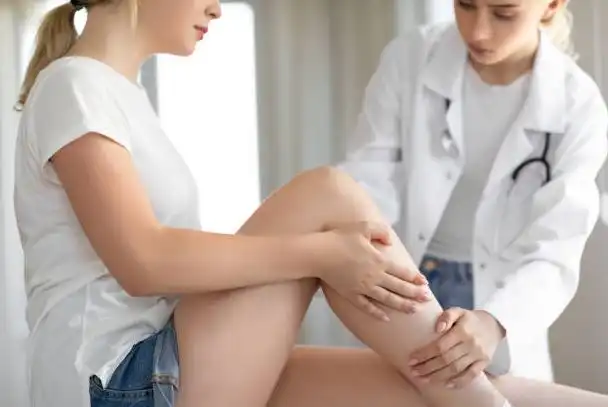What is Restless Leg Syndrome?
Have you ever heard of restless leg syndrome (RLS)? This is a pretty common condition of which the most common symptom is an uncontrollable, irresistible need to move the legs that comes as a result of some kind of discomfort.
Restless leg syndrome can affect people of all ages; however, it typically gets worse as you get older. In addition to simply feeling an urge to constantly move the legs, people with RLS might also experience twitching in their legs, which is a condition commonly known as periodic limb movement of sleep.
It happens more often at night, which can unfortunately lead to an interruption of normal sleep patterns and affect daily production levels as well. That urge to move the legs tends to start as soon as the body goes into a state of rest, which explains why it is more likely to occur at night. But it’s not just something that can happen when you are resting in bed — it can start after you’ve been sitting or lying down anywhere for a long period of time, including a car, plane, movie theater, at your desk, or even at a dinner table if the meal is longer than usual.
Symptoms of Restless Leg Syndrome

Movement is the best way to combat this uncomfortable sensation. Get up and stretch, go for a walk, or pace back and forth if you are in a constricted space. RLS is not to be confused with other conditions that feel like something is happening on the surface of the skin. With RLS, the sensation happens within the limb itself, but it’s not like a muscle cramp. People have described the feelings they experienced as a crawling, creeping, pulling, throbbing, aching, itching or eclectic sensation.
Do some of these symptoms sound familiar? Crawling, throbbing, aching, itching… These are also common symptoms of varicose veins and other venous diseases. Which leads us to wonder: Are restless leg syndrome and varicose veins related, and if so, does varicose veins surgery cure restless leg syndrome?
Restless Leg Syndrome and Varicose Veins
Those symptoms are not the only connection between restless leg syndrome and varicose veins. A common cause of restless leg syndrome is poor circulation, which is also a reason that many people develop varicose veins.
People who spend a lot of time sitting or standing for their jobs, don’t exercise often or lead an inactive lifestyle are at a high risk for lack of proper blood flow in the body. When blood doesn’t flow upward toward the heart as it should, it begins to pool in the veins, causing them to enlarge and feel heavy and achy. This is how varicose veins are formed in the lower body, and restless leg syndrome can form as well.
Another cause of restless leg syndrome is genetics, which also has an effect on whether or not someone develops varicose veins. Pregnancy can bring on RLS, due to the hormonal changes and the extra weight pressure on the legs. Hormones and excess pressure from weight during pregnancy can cause varicose veins too.
Because of the similarities between the two conditions, people who suffer from restless leg syndrome should consider seeing a vein doctor to look for varicose veins and any kind of venous insufficiency. RLS patients could be developing varicose veins and not even know it because they associated their symptoms with the RLS, and never thought that it could also be because of varicose veins.
Can Varicose Vein Treatment Work for Restless Leg Syndrome?
It would make sense to think that if you can successfully treat and get rid of varicose veins, then using the same treatment of varicose veins for restless leg syndrome should work too. According to the Sleep Foundation, one of the recommended treatment options for treating restless leg syndrome symptoms is sclerotherapy, a non-invasive varicose vein treatment that has a high success rate in alleviating the uncomfortable side effects that come with varicose veins, many of which are also experienced with restless leg syndrome.
Varicose Veins Treatment
Fox Vein & Laser Experts offers sclerotherapy as one of the many options for varicose vein treatment. This simple procedure doesn’t require any down time, so it won’t affect your day-to-day routine. You could come into our office for the treatment in the middle of the day, and go right back to work or whatever your obligations may be.
The procedure uses a medicated solution, which is injected into the affected vein through a very fine needle. No surgery or sutures are needed. The solution then disrupts the lining of the vessels and the vein walls stick together, sealing shut, and blood is rerouted to healthy veins. Relief of symptoms is typically felt right away, but the actual removal of the treated veins from the body could take a few weeks. Those veins will turn into scar tissue that the body naturally disposes of, and healthy tissue grows in its place.
Although there is no downtime after a sclerotherapy treatment, it is important to maintain certain lifestyle changes in order to allow the healing process to progress. This includes wearing compression stockings or socks, and adding a regular walking regimen to your routine. Both of these help promote healthy blood flow and circulation and help prevent future varicose veins from developing.
Contact us at Fox Vein & Laser Experts
If you have been diagnosed with restless leg syndrome but have not yet seen a vein doctor Miami, take this as a sign to do so. You could be dealing with underlying venous conditions and not realize it. Left untreated, varicose veins can lead to more serious diseases such as deep vein thrombosis or blood clotting. Call our office at 954-627-1045 to book a consultation with our team to see if varicose vein treatment can help your restless leg syndrome.


